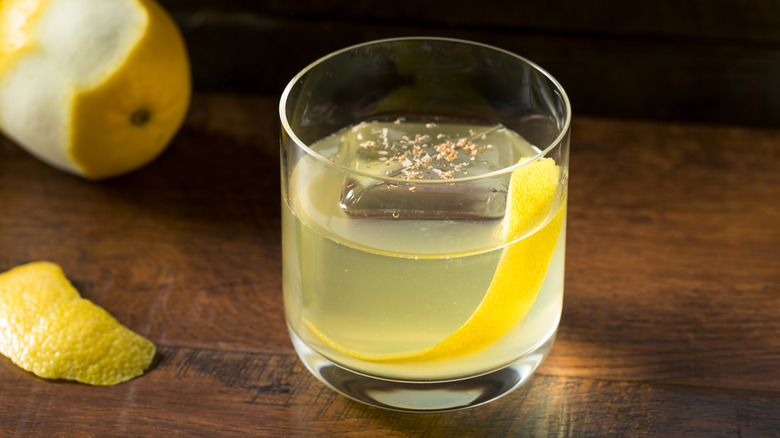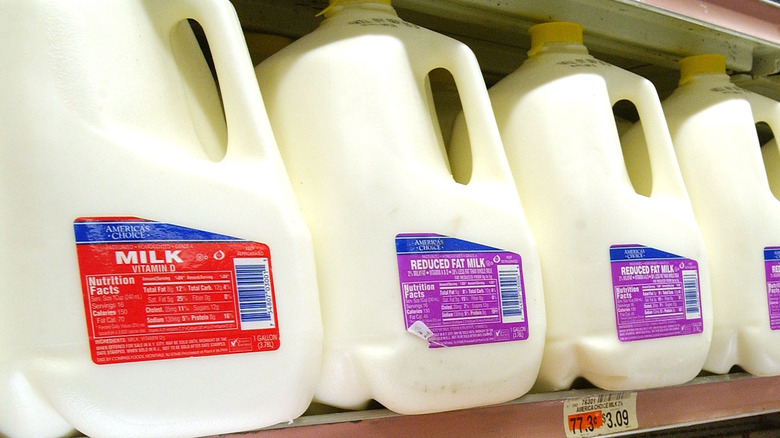Milk Punch Is Having A Moment. Here's The No. 1 Key To Getting It Right
"Milk punch" is a tough two-word phrase to wrap your head around. Milk plus any punch may sound pretty nasty to some. Add in booze, and you might be having flashbacks to someone daring you to take a cement mixer shot. If that memory triggers an upset stomach, don't worry: This drink is far from a prank cocktail.
Milk punch can go in many directions. In New Orleans, bourbon milk punch ranks among the best hot bourbon drinks of all time. That creamy delight can go in many directions, including a cereal-spiked Fruity Pebbles bourbon milk punch. That's one of many milky cocktails that look a lot like eggnog — not that there's anything wrong with that.
Generally speaking, milk punch is in the midst of a bona fide moment. In this case, milk as an ingredient plays a role in the prep phase of the cocktail, but the end result doesn't exactly include milk as we think of it in its final iteration — well, not exactly, at any rate. That sounds confusing, but it's a straightforward technique that produces crystal clear, velvety smooth cocktails for a crowd. Best of all, any leftovers (not likely) can be at the ready, in the fridge, for up to a month.
Milk punch's moment is centuries in the making
A better name is probably clarified milk punch, and it's been around since the 17th century. However, it wasn't until the past few decades that this technique was embraced by bartenders specializing in unique cocktails. When milk is added to a blend of spirits, and citrus juice, the milk curdles. Those curds are masses of milk protein that act like nets that collect bitter tannins and much of the color. After a few hours, remove the curds via straining, and the resulting liquid is much lighter in color, with a rounded flavor and silky texture.
Classic recipes are usually made from rum or brandy and lemon juice. Combine those and stir in milk. The acidity will immediately cause the milk to curdle. As those curds grow, they'll keep clarifying the cocktail. A few hours will do, but overnight is better. Cocktail bars love this technique because the prep can happen hands-free during off-hours.
Remember, all that clarification will be for naught unless this is strained thoroughly. For that, a fine-mesh strainer should be lined with a few coffee filters or more layers of cheesecloth over a pitcher. Pour the curd mixture over this, and watch the vessel fill with a glistening milk punch. Cover and refrigerate till you pour this, neat or on the rocks, into the glass of your choice.
To make your own milk punch, focus on the milk
Using this technique, you can get creative with the spirits and variety of citrus, and scale the recipe up or down to suit your party size. Remember, once the milk punch has been strained, it will last up to a month if kept covered and refrigerated. So even if you don't have a party planned, you can have cocktails ready to go at a moment's notice.
As far as those curds in the strainer — they present options, too, and aren't always destined for the trash. In some cases, the curds (and all of the flavor they've trapped) are added back into the cocktail. These milk-washed spirits use the curds to create a unique, frothy mix. Even though all the flavor and color are returned, the result is an exceptionally smooth drink.
The one thing that shouldn't be toyed with is the milk. For the best results, the milk needs to be animal-based. Vegetable-based milk doesn't curdle as well and can lend off flavors. Ideally, you should use whole milk since lower-fat milk doesn't curdle as easily. Higher-fat milk options won't be as clear and can lend strange flavors, too. Whole milk curdles well and allows the spirit and citrus to remain as the flavor focus.


